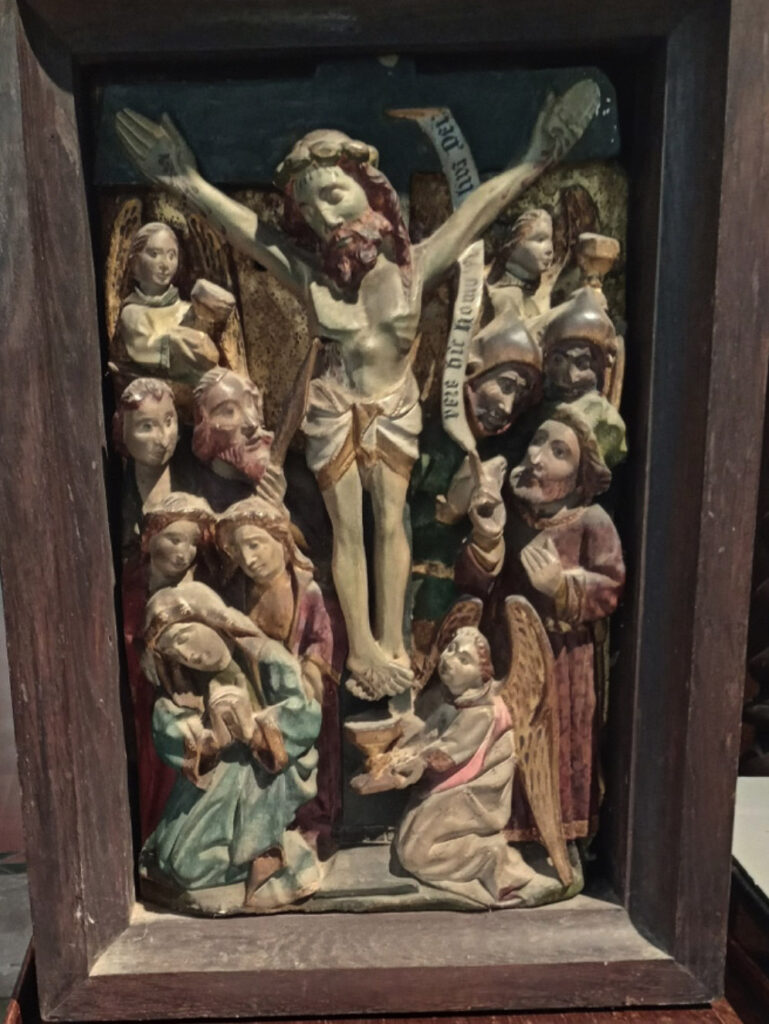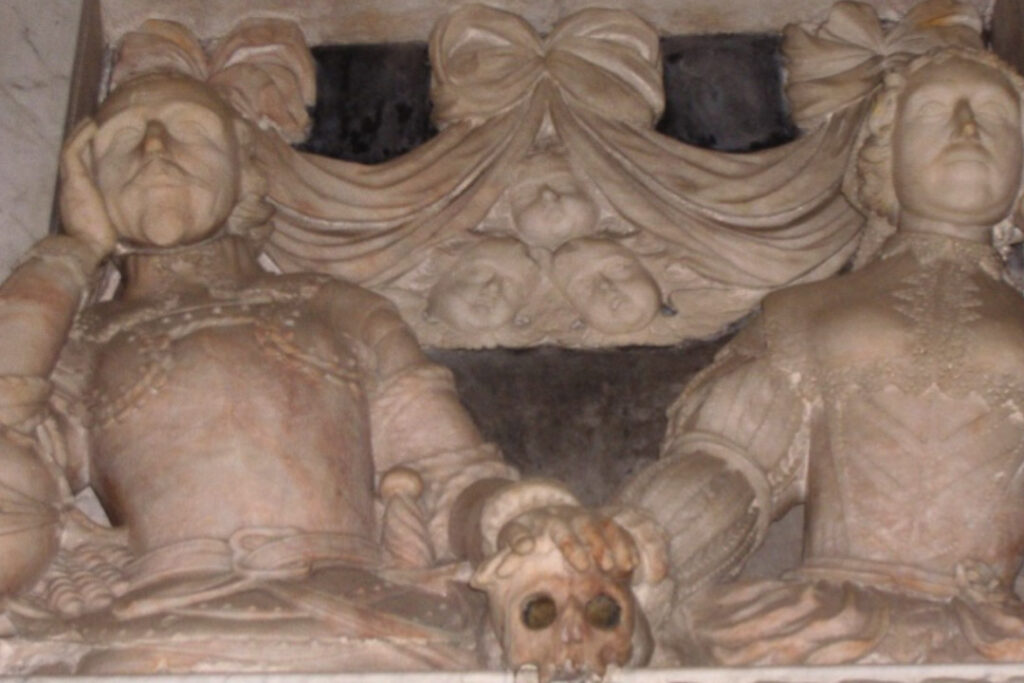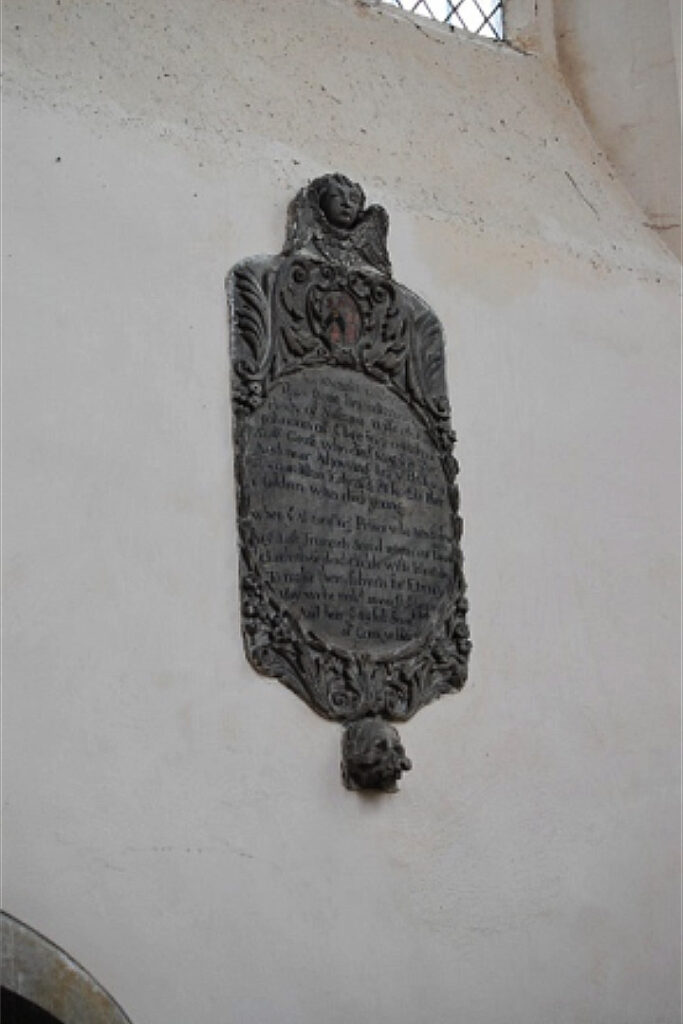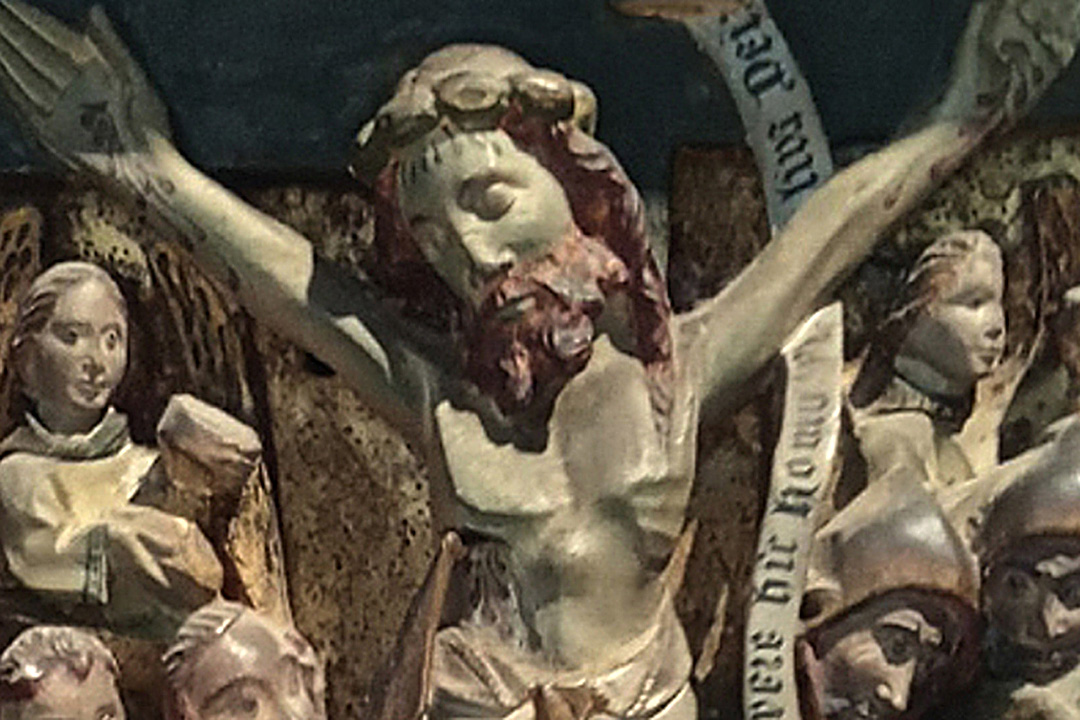At the launch of the St Mary’s Appeal in January this year, the church displayed some fascinating artefacts to accompany a talk by Roy Tricker.
Coddenham History Recorder John Pelling, takes up the story.
The scroll held by the man on the right carries the Latin words that mean “truly this man was the son of God.” There is a mystery about this image that we may never solve. A beginning can be made, however, and in the process perhaps some clues may be identified.

First, a book donated to the Village History Society by William Murrell Lummis records that it was discovered hidden in the attic of the “Old Vicarage” in 1744. Before that it was supposed to have been in a tunnel between the church and the vicarage. The late Helen Wyles believed the tunnel ran from the church to Manor Farm. However, no trace of such a tunnel has been found.
Second, it is suggested that the image did not originally belong to St Mary’s but to the Cistercian nunnery reputed to have existed in Coddenham during the Middle Ages. Religious houses were suppressed after the Reformation, when Henry VIII ended his allegiance to the Roman Catholic church. Henry’s son, Edward VI, advised by a council of Puritan ministers, ordered that all so-called superstitious images be destroyed. The image would have been among them had it been found.
We know there was a good reason to hide the image, therefore, if whoever was responsible had kept some faith in the old religion. A pious gesture, assuming the image had been in the convent before the Reformation, would have been to place it in the care of the vicar.
Our first clues are in two wills written in Coddenham. Joan Coke (or Cooke) wished to “give and bequeath to the candlebeam … toward the making 40 shillings.” The candlebeam was the chancel screen with the rood or carving of the crucifixion on its top beam. This beam would have been wide enough to walk on in lighting its candles. Joan Boor gave 4s 4d for “a taper of wax” to burn before the rood loft for as long as it will endure.”[1]
Those wills, written in 1525 and 1528 respectively, would have been when the rood screen was under construction; its completion, according to the date inscribed on it (unique in Suffolk) was in 1530. Between 1533 and 1538 all rood screens in English churches were removed and many images were burnt. It was forbidden to burn votive candles.
Joan Cooke’s legacy was proof of her wealth. It also proves how supportive prosperous villagers were of Roman Catholic practice. She was buried in the chancel beside her husband, William Cooke. Any inscription on their grave, Matthias Candler wrote a century later, was removed as “superstitious” (meaning it was Roman Catholic).
Two of the surviving panels with inscriptions from the rood screen.
Surviving panels of the rood screen show saints, also thought superstitious by Tudor and later Puritans. Presumably these were whitewashed to protect them from view and destruction.


The Wenhaston Doom in East Suffolk was similarly whitewashed and only recovered after being left in the churchyard, where traces of its paintwork were revealed after a shower of rain. The Barnardiston pew at Kedington in West Suffolk was also whitewashed, almost certainly on instructions of the notably Puritan manorial family. Its non-figurative paintwork was restored in the 1920s.
Was the crucifixion placed in care of the vicar? A case can be made for this because the vicar at the time was James Glover. Candler wrote he “could change with all times.” This was crossed through in Candler’s manuscript but still gives Candler’s opinion of him. Glover was instituted as vicar in 1541 under the patronage of Henry VIII, who died in 1547. He remained through the reigns of Edward VI, Mary I (who reimposed Catholicism) and for the first four years of Elizabeth I. At that time Elizabeth was tolerant, as Henry had been, and only after plots against her did she allow her ministers to prosecute Catholics. If Glover had placed the image in the church during Mary’s reign there would have been no reason for him to remove it.
Opinion regarding church ritual is more likely to have been of interest to families like the Cookes than of poor people, who had no money to pay for prayers to save their souls. A century after the Reformation even well-off individuals trusted in the merits of Jesus rather than intercession for their salvation. Robert Cooke (perhaps a descendant) was wealthy enough to have land in Coddenham, Gosbeck and Hemingstone, with sufficient funds to leave legacies of £100 each to his three children. Daniel Richar was less wealthy than Cooke but also hoped “through merits, death & passion of lord & saviour Christ, to have everlasting life” and requested his “friend[s] Matthias Candler … and William Dusing [Dowsing]” to resolve any disputes regarding his will. Candler and John Daines of Manor Farm were asked to supervise legacies from the will of Thomas Daines, a tailor, of Coddenham. No mention of the church fabric or of prayers is mentioned in these wills.
It was plainly not the case that people had any faith in images. These three wills were made in 1627 and 1628, early in the reign of Charles I, who was to be accused of trying to reintroduce Catholicism when he approved of Archbishop Laud’s style of ritual. Ministers like Candler were reproved by Bishop Wren of Norwich for perceived failings in practice. For their part such ministers would sign petitions for abolition of church hierarchy. It was a contradictory time for any remnant of the old religion.
To illustrate the change since the Reformation the memorial in Kedington church, to Sir Nathaniel and Lady Jane Barnardiston, has no overtly religious image, although this couple was renowned for piety. The dust jacket of the book of wills, from which the three above are taken, has a deathbed scene in uncoloured alabaster with two winged figures carrying away the dead man’s soul. It is suggested that this illustrates the parable of Dives and Lazarus.[2] The use of parable suggests not reliance of one’s own good works, still less on the intercession of saints, but avoidance of evil. The memorial to another Barnardiston, in Clare church, places her trust in Jesus to ‘be ranked among the saints’ not in the intercession of saints

Sir Nathaniel and Lady Jane Barnardiston 1653

Susanna Johnson née Barnardiston
Between the dates of the wills and the Barnardiston memorial, William Dowsing was commissioned by the Earl of Manchester to visit churches and remove or destroy popish images. An illustration of that time, 1643, shows Puritans casting images into a bonfire.[3] The two clearest images are a friar and a worshipper kneeling before the crucifixion.
Dowsing came to Coddenham and ‘gave orders’ for the removal of three crosses from the steeple [tower] and one from the chancel. No order was made regarding the angels affixed to roof timbers. They had presumably been removed at the Reformation. One is thought by Roy Tricker[4] to be original, suggesting it had been hidden somehow, like the alabaster image. Perhaps this too had been given into the care of the vicar or an influential local worthy. Could it have been taken down by the craftsman who built the rood screen only a few years before the Reformation?
It seems possible, from the little that is known of the relationship between Dowsing and Candler, that the vicar knew in advance of the commissioner’s intention and forestalled him by having the alabaster image hidden. He was opposed to bishops but not necessarily an iconoclast. Like other clergymen he may have wished for moderate reform and, when it happened in 1649, would have been appalled by the execution of the king. There is no way of knowing, but it is clear he was not so ‘godly’ as to resist his son’s marriage to Deborah Golty, daughter of an alleged royalist and Laudian priest.[5] That her father had married the daughter of John Ward of St Clement’s, Ipswich, a godly minister and brother of the renowned Samuel, late town preacher of Ipswich, shows there could be sympathy between opponents within the church. Candler refers in one manuscript to ‘sectaries’ [zealots] conspiring against Golty, which led to his removal from his parish in Framlingham to the family home at Ashbocking, where he continued to preach.[6]
Incidentally, the memorials to Candler and John Ward may have been made by Caius Gabriel Cibber. Ward’s monument includes Hebrew words meaning ‘Death is the real victory for the godly,’ whereas Candler’s states: ‘Solid in divinitie, Laborious in’s ministry, Heavenly in society, a mirror of sound pietie, Here the weary be at rest.’[7] These words were quoted a century later by the shoemaker, plantsman and churchwarden, Richard Hammond, of the Crown inn, as suitable guidance for a priest.[8]
John Pelling : February 2024
[1] Proceedings of the Suffolk Institutes of Archaeology and History, 2014, 224.
[2] Wills of the Archdeaconry of Suffolk, 1627-1628, 2014.
[3] Gaskill, M., Witchfinders, 2006, 79.
[4] Mentioned in a talk given in the church, January 2024.
[5] Gaskill, 109.
[6] British Library BL15220 microfiche in the Hold Ipswich.
[7] Proceedings of the Suffolk Institute of Archaeology and History, 2000, 464.
[8] Proceedings, 1995.

Fascinating John, thank you for all the research you have done.